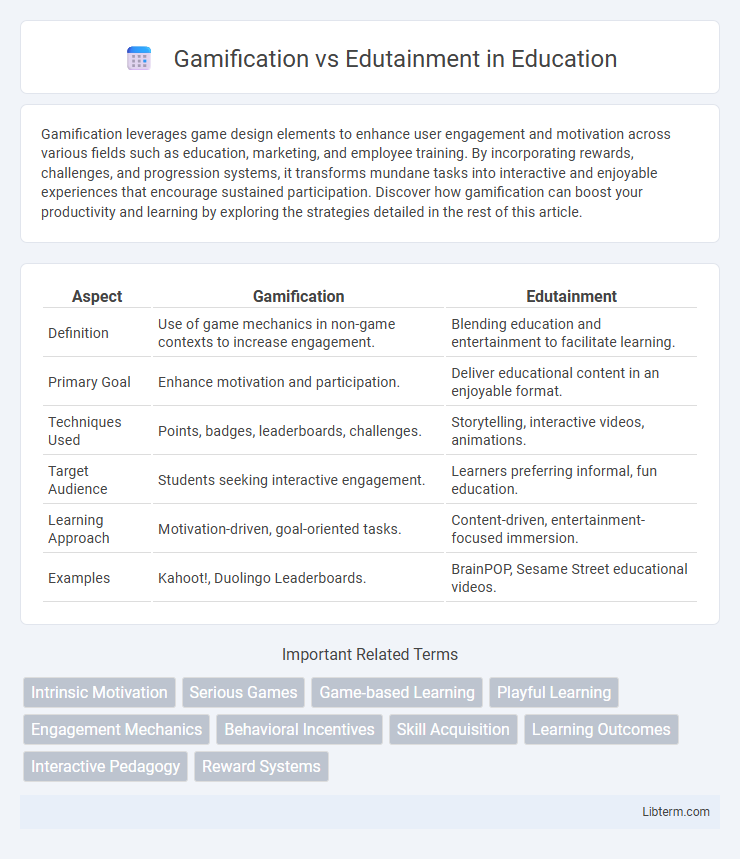Gamification leverages game design elements to enhance user engagement and motivation across various fields such as education, marketing, and employee training. By incorporating rewards, challenges, and progression systems, it transforms mundane tasks into interactive and enjoyable experiences that encourage sustained participation. Discover how gamification can boost your productivity and learning by exploring the strategies detailed in the rest of this article.
Table of Comparison
| Aspect | Gamification | Edutainment |
|---|---|---|
| Definition | Use of game mechanics in non-game contexts to increase engagement. | Blending education and entertainment to facilitate learning. |
| Primary Goal | Enhance motivation and participation. | Deliver educational content in an enjoyable format. |
| Techniques Used | Points, badges, leaderboards, challenges. | Storytelling, interactive videos, animations. |
| Target Audience | Students seeking interactive engagement. | Learners preferring informal, fun education. |
| Learning Approach | Motivation-driven, goal-oriented tasks. | Content-driven, entertainment-focused immersion. |
| Examples | Kahoot!, Duolingo Leaderboards. | BrainPOP, Sesame Street educational videos. |
Understanding Gamification: Key Concepts
Gamification involves applying game design elements such as points, badges, and leaderboards to non-game contexts to enhance motivation and engagement. Core concepts include mechanics, dynamics, and aesthetics, which work together to create compelling user experiences that drive desired behaviors. Understanding these key elements helps distinguish gamification from edutainment, which focuses more on entertaining educational content rather than behavior-driven game mechanics.
Defining Edutainment in Modern Learning
Edutainment in modern learning integrates educational content with entertainment elements to enhance engagement and retention. It leverages multimedia tools, interactive activities, and storytelling to create an immersive experience that motivates learners while delivering knowledge. This approach contrasts with gamification by emphasizing narrative and enjoyment alongside instruction rather than primarily using game mechanics to drive participation.
Core Differences Between Gamification and Edutainment
Gamification incorporates game mechanics such as points, badges, and leaderboards into non-game contexts to boost user engagement and motivation, primarily focusing on achieving specific learning or behavioral outcomes. Edutainment blends educational content with entertaining elements like storytelling, animation, or interactive experiences to create immersive learning environments aimed at enjoyment and knowledge absorption. The core difference lies in gamification's intent to enhance existing processes through game-like incentives versus edutainment's goal to make education inherently entertaining through integrated content design.
Psychological Impacts on Learners
Gamification leverages game mechanics such as points, badges, and leaderboards to enhance motivation and engagement by triggering the brain's reward system, fostering intrinsic motivation and sustained learning interest. Edutainment blends educational content with entertainment elements, reducing cognitive load and promoting positive emotional states that facilitate memory retention and knowledge absorption. Both approaches improve learner psychological outcomes by enhancing motivation, engagement, and emotional involvement, but gamification specifically targets goal-oriented behavior and self-efficacy, while edutainment emphasizes a balanced, enjoyable learning experience.
Motivational Strategies in Gamification
Motivational strategies in gamification leverage intrinsic and extrinsic rewards such as points, badges, and leaderboards to enhance learner engagement and drive sustained participation. These techniques capitalize on game mechanics like challenges, feedback loops, and goal setting to foster a sense of achievement and progression. Unlike edutainment, which blends education with entertainment primarily for enjoyment, gamification strategically incorporates motivation science to improve learning outcomes and behavioral change.
Engagement Tactics Used in Edutainment
Edutainment employs interactive storytelling, game mechanics, and multimedia elements to boost learner engagement, blending education with entertainment seamlessly. Techniques such as immersive simulations, rewards systems, and adaptive feedback create an engaging learning environment that motivates users to participate actively. By leveraging emotional connections and narrative-driven content, edutainment sustains attention and enhances knowledge retention more effectively than traditional methods.
Real-World Applications in Education
Gamification in education leverages game design elements like points, badges, and leaderboards to increase student engagement and motivation through real-world applications such as interactive quizzes and progress tracking systems. Edutainment combines educational content with entertainment methods, using tools like educational videos, simulations, and storytelling to make learning immersive and enjoyable. Both approaches enhance learning outcomes by applying cognitive psychology principles to foster active participation and retention in diverse educational settings.
Advantages and Disadvantages of Gamification
Gamification enhances user engagement by incorporating game elements such as points, leaderboards, and badges into non-game contexts, driving motivation and improving learning outcomes. However, it can lead to extrinsic motivation dependence, reducing intrinsic interest, and may cause frustration if game mechanics overshadow educational content. The balance between challenge and reward is critical, as poorly designed gamification can result in shallow engagement or cognitive overload.
Benefits and Challenges of Edutainment
Edutainment combines educational content with engaging entertainment formats to enhance learning retention and motivation, making complex subjects more accessible and enjoyable for diverse audiences. Benefits include increased learner engagement, improved knowledge assimilation, and interactive experiences that cater to different learning styles. Challenges involve maintaining a balanced focus between education and entertainment, avoiding oversimplification of content, and ensuring consistent educational value without distracting entertainment elements.
Choosing the Right Approach: Gamification or Edutainment?
Choosing the right approach between gamification and edutainment depends on your learning objectives and audience engagement goals. Gamification integrates game mechanics like points, badges, and leaderboards to motivate and increase participation, making it ideal for skill reinforcement and habit formation. Edutainment blends educational content with entertainment, using storytelling and interactive media to enhance understanding and retention in learners seeking an immersive experience.
Gamification Infographic

 libterm.com
libterm.com